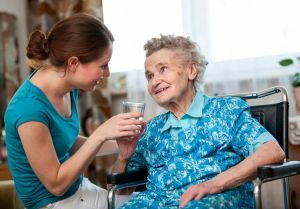 Senile degeneration of the brain is also known as senile senility or dementia. The first prerequisites for the development of brain dystrophy can occur in a person after 60 years, although memory loss over time is not a normal phenomenon.
Senile degeneration of the brain is also known as senile senility or dementia. The first prerequisites for the development of brain dystrophy can occur in a person after 60 years, although memory loss over time is not a normal phenomenon.
The concept of degeneration means the weakening or loss of special functions by the body. Dementia( dementia) is a chronic mental disorder, in which behavioral disorders and loss of basic self-care skills are possible.
Thus, there is a violation of higher cortical functions. Senile( senile) degeneration of the brain is most often diagnosed in people who have reached the age of 65.
Content
- overall clinical picture
- types and stages of violations
- Causes and clinical degenerative processes
- vascular etiology dystrophy
- Dementia altsgeymerskogo type
- Dystrophy brain alcoholic type
- senile
- Epileptic dementia
- The diagnosis
- What can offer modern medicine
- Features care
- Casesthe death of
The general clinical picture of
Patients have a disorder of thinking, weakening of memoriesand attention, lethargy and inactivity, a violation of the emotional state.
Disorders of higher functions of the cerebral cortex are noted, this is manifested in agnosia, apraxia, aphasia and other pathologies. At the same time the patient is not oriented in the society, the consciousness can remain clear. If this condition lasts more than 6 months, senile dementia occurs.
Types and stages of violation of
In medical practice, three degrees of degenerative disorders in the brain are distinguished:
- Easy degree of .It is characterized by loss of professional skills, apathy to what is happening around. The patient is not interested in subjects that were previously considered his hobby. In this degree of illness, orientation and consciousness persist.
- Average degree of .The patient copes with the skills of personal hygiene, but can forget the rules for using household appliances. Such people often need help, leaving them unattended is dangerous.
- Heavy Duty .Patients lose orientation in space and are unable to serve their own needs.

Degenerative diseases of the brain can be expressed in total or lacunar form.
- The total form of the disorder is characterized by scant emotionality and apathy. There is a degradation of personality.
- The lacunary( partial) form of the is characterized by a short-term memory failure. But the "core of the personality" is preserved.
The course of the disease occurs in stages:
- The is a stage of an illness characterized by memory loss, absent-mindedness and apathy. Ability to think abstractly decreases. Thus, violations affect the fresh layers of memory.
- Early degeneration of ( the second stage of the disease) is characterized by more severe disorders. Progressive disease is expressed in violation of motor activity, incoherent speech. The patient can not always express his thoughts, his movements
 are ridiculous, but the remnants of memory and sanity remain.
are ridiculous, but the remnants of memory and sanity remain. - Moderate dementia of ( the third stage) manifests itself in that a person begins to confuse words, does not recognize his loved ones, partially loses his reading and writing skills. There can be elements of delirium. An elderly person is able to leave the house, and return for him back, because of a disturbance of consciousness, is not possible. In addition to these symptoms, patients no longer control the natural needs of the body.
- After these stages, severe dementia occurs. The person practically does not talk, does not get out of bed and loses the ability to perform the most elementary movements. This leads to exhaustion of the body. Death occurs because of pneumonia or bedsores that have arisen under such conditions.

Causes and clinic of the dystrophic processes
The causes of the impairment of brain functions in old age can be:
- In the case of vascular dementia , a history of hypertension, atherosclerosis, stroke. Thus, the cause of this pathology is the impaired blood supply to the brain. For this reason, mass death of neurons occurs. In this case, pathology is considered incurable. Cells have a low ability to recover in old age.
- In the atrophic type of dementia of , a history of Pick, Alzheimer's, Parkinson's disease should be noted. Here there is a cerebral-vascular insufficiency. Alzheimer's disease affects older women more often. The prerequisites for occurrence are genetic predisposition, alcohol and smoking, severe stress, thyroid pathology or craniocerebral trauma.
- Mixed type is characterized by a combination of vascular pathologies with atrophic changes.
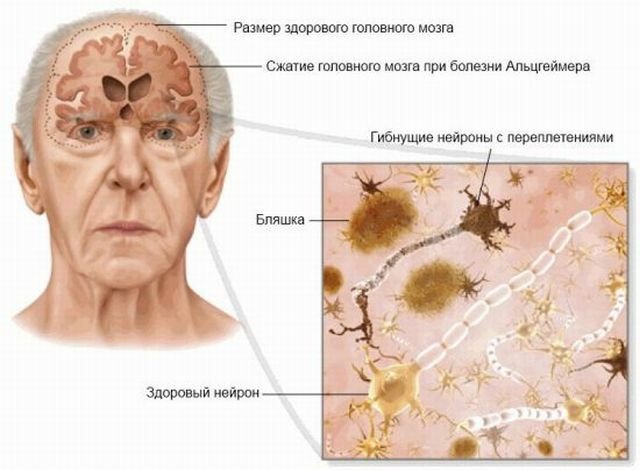
Among the causes of the disease are also brain tumors, chronic alcoholism, severe viral infections.
Vascular etiology of dystrophy
Vascular dementia accounts for 25% of cases. It develops in chronic oxygen starvation of cells of the brain substance due to vascular disorders in the organ. The cause may be congenital vascular defects, diabetic angiopathy and stroke.
People at risk are people with a sedentary lifestyle, with malnutrition and alcohol dependence. Subjected to vascular degeneration are patients with obesity, diabetes, arterial hypertension and atherosclerosis.
In this pathology, the patient is disturbed by the process of thinking, he is unable to distinguish the logical connection of events. A person loses his things, which are in sight. Appearance loses neatness. In this state, there is often a tearfulness, apathy, an unpredictable change of mood. Because of the decrease in motor activity, a person sleeps a lot.
Alzheimer's Dementia
Despite the fact that this type of disease is the most common, it is very difficult to distinguish it from vascular dementia. Often the correct diagnosis is determined after the patient's death.
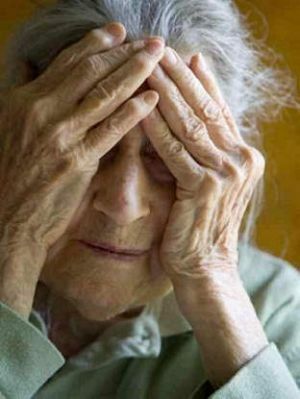 In a risk group, women after age 70, patients with atherosclerosis and diseases of the endocrine system, people with adverse heredity.
In a risk group, women after age 70, patients with atherosclerosis and diseases of the endocrine system, people with adverse heredity.
At the beginning of the development of Alzheimer's brain degradation, there is a decrease and a partial loss of short-term memory, and later a long-term memory loss.
Patients may have an aggressive condition. They behave rudely, they do not have enough attention of relatives.
Progressive pathology further causes delusions of persecution, megalomania and other such deviations.
The propensity to vagrancy is manifested by frequent departures from home. The patient's appearance is untidy.
Alzheimer's Brain Dystrophy
This condition develops in people with alcohol dependence for 10-20 years. It is characterized by aggressive behavior, a violation of intellectual qualities and apathy.
But in rare cases, when the harmful dependence is abandoned, the pathological process regresses.
Aged senility
Aged people become distracted and grouchy, intractable. Forgetfulness and behavior change occur due to aging and extinction of brain cells.
Patients may be suffering from insomnia at night, they tend to sleep during the day. For them, mental disorders, resentment and tearfulness are typical. May be observed apathy and even hallucinations.
The cause of these disorders can be blood pressure jumps and hyperglycemia.
Epileptic dementia
This is a secondary disease in the background of epilepsy. It is also called functional dementia.
To this state lead to oxygen starvation and the consequences of head injury, brain tumors. There is a decrease in memory and a violation of cognitive abilities, accompanied by an indifferent attitude toward what is happening.
Patients become coarse, selfish and vindictive. A characteristic feature is the use of most of the words of a poor lexicon in a diminutive manner. With this form of the disease, therapy is aimed at eliminating the underlying cause.
Statement of diagnosis
For an accurate diagnosis is going to anamnesis. On its basis, the symptoms differentiate with depression, severe asthenia and 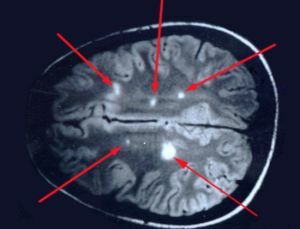 with iatrogenic mental disorders( delirium, simulation and others).
with iatrogenic mental disorders( delirium, simulation and others).
The neurologist, when examining a patient, identifies focal symptoms, extrapyramidal disorders and disturbances in walking.
The final diagnosis is made based on the results of magnetic resonance imaging and laboratory tests of the patient.
What modern medicine can offer
Treatment of brain dystrophy of any genesis and maintaining a stable state of patient's health consists of two main methods:
- drug therapy;
- care.
Senile degeneration of the brain is treated with concomitant diseases, which the patient can have a lot by this age. These include hypertension, pneumonia, heart attacks and strokes and many others. The patients are treated with preparations of plant origin and synthetic ones.
The first group of drugs include psychostimulants. Their action is aimed at increasing the ability of the 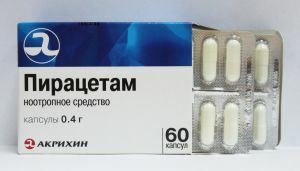 nervous system to adapt to stresses. The second group of drugs are nootropics, whose action is aimed at restoring memory and improving the function of the cognitive functions. This group is able to reduce the need for the brain in oxygen.
nervous system to adapt to stresses. The second group of drugs are nootropics, whose action is aimed at restoring memory and improving the function of the cognitive functions. This group is able to reduce the need for the brain in oxygen.
Treatment of senile dementia involves the use of drugs that are capable of restoring nerve tissue to the brain. Their effect is somewhat weakened by combinatorial treatment with drugs that improve blood supply in the organ. But the results of treatment still have a positive trend.
The feeling of causeless fear, anxiety, insomnia is treated with the use of tranquilizers. Patients may need psychotherapeutic methods of influence, capable of returning a person to normal behavior.
Features of care
Medication therapy will not give the expected effect without proper care. Close patients should know that at home it is almost impossible to create the right conditions.
This is explained by the fact that the house has a large number of dangerous objects for the patient( cutting, stitching, electrical and fire-hazardous).In addition, because of the possible aggression of the patient, it is very difficult to stay calm in the house. Nutrition of patients must be monotonous.
Their cognitive abilities are disturbed, and the variety of dishes can cause unpredictable confusion. Elderly people need help in visiting the toilet. You may need to use special items of hygiene( diapers).
From all this it follows that the best option is to place the patient in a specialized medical institution or care of a professional nurse.
The patient should be treated with respect. His behavior is a manifestation of a serious illness, not a character trait. With a positive attitude, good, patient care, there is a significant improvement in the condition.
Cases of death
In the absence of therapy from the onset of manifestations of the disease to the final stage is about 7 years. 
With the rapidly progressing vascular form of senile brain degeneration, death may occur within a few months after the first symptoms of the disease are identified, because patients in the last, severe stage of the ailment give up motor activity and eating, become apathetic, which leads to complete exhaustion.
They have a tremor of extremities, speech is present in the form of scraps of phrases. About themselves they remember very little. All the time the patient is in a prone position, as a result of bedsores, sepsis and pneumonia. The weakened organism ceases to fight, and a fatal outcome occurs. Mortality from the total number of cases is approximately 5.6%.
The lifespan of an inoperable patient with a malignant brain tumor where senile degeneration is considered secondary can be predicted by the oncologist according to laboratory and MRI findings.
Special prevention of senile dementia in medicine does not exist yet. To avoid disturbances of brain activity, people over 40 are recommended to take a complex of vitamins and microelements.
There are biologically active additives, whose action is aimed at improving memory and thinking ability. An important aspect is the rejection of bad habits, detrimental to the brain and the cardiovascular system.
Effective therapy for the manifestation of somatic pathologies in the elderly can also play a preventive role. It is important that measures are taken in a timely manner.



